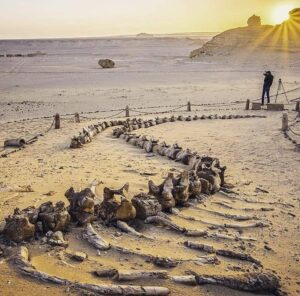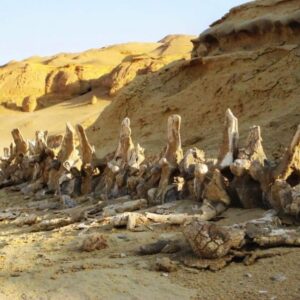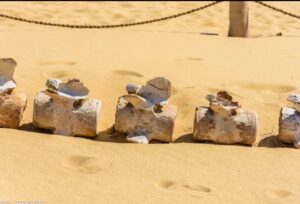Description Of Fayoum Wadi Al-Hitan
- Fayoum Wadi Al-Hitan is a unique and fascinating area located in Egypt. It was designated as a UNESCO World Heritage Site in 2005, due to its importance as an area of scientific significance for the study of paleontology. The site provides evidence that whales evolved from land mammals, making it one of the most important fossil sites in the world.
- The main attraction at Fayoum Wadi Al-Hitan is its abundance of whale fossils dating back to 40 million years ago during the Eocene period when whales first began their transition from land mammals into aquatic creatures. This site contains some 150 fossils including skeletons and skulls which have been remarkably preserved over time through sedimentary rock formation processes such as sandstone deposition and limestone accumulation. These fossils provide invaluable insight into how these animals made this evolutionary leap millions of years ago, allowing us to better understand our own history on earth today.
- Visitors can explore Fayoum Wadi Al-Hitan by taking guided tours or going on self-guided hikes along marked trails throughout the protected reserve where they will be able to observe both marine life still living there today such as flamingos and turtles alongside ancient whale remains scattered across this beautiful desert landscape providing an incredible juxtaposition between past life forms with current day wildlife species inhabiting this region.. All visitors are encouraged not only take pictures but also leave no trace behind so future generations may continue enjoying all that Fauyoum has offer for many more centuries ahead!
- Wadi Al-Hitan, Whale Valley, in the Western Desert of Egypt, contains invaluable fossil remains of the earliest, and now extinct, suborder of whales, Archaeoceti. These fossils represent one of the major stories of evolution: the emergence of the whale as an ocean-going mammal from a previous life as a land-based animal. This is the most important site in the world for the demonstration of this stage of evolution. It portrays vividly the form and life of these whales during their transition. The number, concentration and quality of such fossils here is unique, as is their accessibility and setting in an attractive and protected landscape. The fossils of Al-Hitan show the youngest archaeocetes, in the last stages of losing their hind limbs. Other fossil material in the site makes it possible to reconstruct the surrounding environmental and ecological conditions of the time.






- The globally important fossils of Wadi Al-Hitan (Whale Valley), in the Western Desert of Egypt, provide dramatic evidence of one of the iconic stories of evolution: the emergence of whales as ocean-going mammals, from their previous life as land-based animals.
- The World Heritage property is a strictly protected zone, set within the wider landscape of the attractive Wadi El-Rayan Protected Area. It is an exceptional global reference site because of the number, concentration, quality and accessibility of the evidence of the earliest whales, often in the form of complete skeletons, and the record of the environment that they lived in.
- Wadi Al-Hitan is the most important site in the world to demonstrate one of the iconic changes that make up the record of life on Earth: the evolution of the whales. It portrays vividly their form and mode of life during their transition from land animals to a marine existence. It exceeds the values of other comparable sites in terms of the number, concentration and quality of its fossils, and their accessibility and setting in an attractive and protected landscape.
Integrity
- Wadi Al Hitan is of sufficient size to include the main exposures of rocks where the whale fossils are found, as well as associated geological features of interest. In addition, a wider part of the Wadi El-Rayan Protected Area is included in the property, including the immediate landscape surrounding the fossil sites, areas of scenic interest, and areas which provide visitor access and facilities. A buffer zone has been identified to protect the property from wider threats, including from visitation and traffic, and could be extended further in order to provide additional safeguards and to facilitate management.
Protection and management requirements
- Wadi Al-Hitan is State owned and has strong and unequivocal legal protection under the Egyptian Law 102/1983 for Nature Protectorates reserves, forbidding actions that would lead to destruction or deterioration of the natural environment. The law mentions geological features as specific elements receiving protection.
- The property lies within the Wadi El-Rayan Protected Area (WRPA), declared by Prime ministerial Decree No. 2954/1997. It is managed under national regulatory law on Nature Protectorates. The Nature Conservation Sector (NCS) of the Egyptian Environmental Affairs Agency (EEAA) is responsible for the management, protection and conservation of the entire site, as part of its overall management of the WRPA
- An effective management system is in place for the property, as an integrated part of the implementation of the Management Plan for the WRPA. Under the updated Management Plan (2008-2013) the property is identified as a “World Heritage Zone”. No vehicle access is permitted, whilst zones provide for well-controlled eco-tourism in part of the property, whilst maintaining areas for research and studies. The buffer zone is also managed as a part of the World Heritage Zone within the WRPA. Effective and well designed visitor facilities are provided to present the property, guide visitors to key localities via footpaths, prevent vehicular traffic in the property and provide for limited on-site accommodation. There is a planning team responsible for day-to-day management of the property, and the preparation of annual plans and monitoring and reporting on the effectiveness of its management.
- Maintenance of an effective and well-resourced management plan, supported by adequate staff, finance and resources is an essential long term requirement. Amongst the key management issues are the protection, conservation and encouragement of well-managed research in relation to the fossil remains and the associated geological values, to international standards of best practice. Other important long-term management needs are the continued protection of the property from damage by traffic of vehicles, the provision and maintenance of the essential management infrastructure within the property that minimises intrusion and damage to its natural values, and the provision of facilities for sustainable tourism at appropriate levels of visitation.
